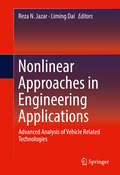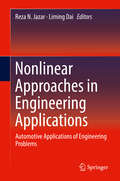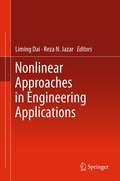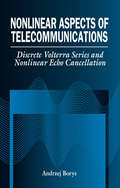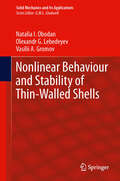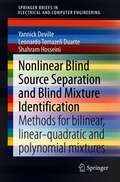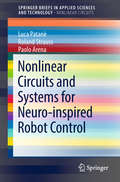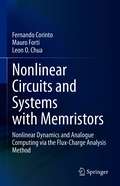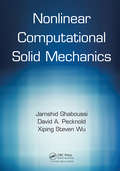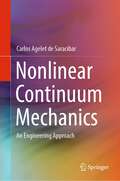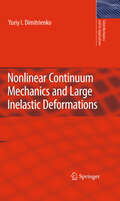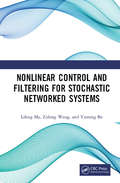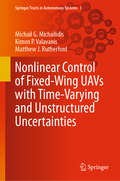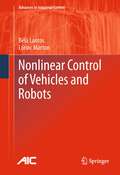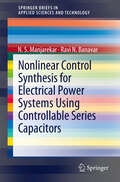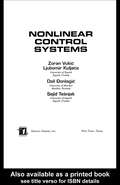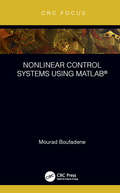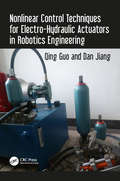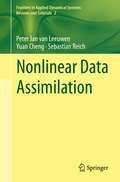- Table View
- List View
Nonlinear Approaches in Engineering Applications
by Reza N. Jazar Liming DaiNonlinear Approaches in Engineering Applications focuses on nonlinear phenomena that are common in the engineering field. The nonlinear approaches described in this book provide a sound theoretical base and practical tools to design and analyze engineering systems with high efficiency and accuracy and with less energy and downtime. Presented here are nonlinear approaches in areas such as dynamic systems, optimal control and approaches in nonlinear dynamics and acoustics. Coverage encompasses a wide range of applications and fields including mathematical modeling and nonlinear behavior as applied to microresonators, nanotechnologies, nonlinear behavior in soil erosion,nonlinear population dynamics, and optimization in reducing vibration and noise as well as vibration in triple-walled carbon nanotubes.
Nonlinear Approaches in Engineering Applications: Automotive Applications of Engineering Problems
by Reza N. Jazar Liming DaiThis book focuses on the latest applications of nonlinear approaches in engineering and addresses a range of scientific problems. Examples focus on issues in automotive technology, including automotive dynamics, control for electric and hybrid vehicles, and autodriver algorithm for autonomous vehicles. Also included are discussions on renewable energy plants, data modeling, driver-aid methods, and low-frequency vibration. Chapters are based on invited contributions from world-class experts who advance the future of engineering by discussing the development of more optimal, accurate, efficient, cost, and energy effective systems. This book is appropriate for researchers, students, and practising engineers who are interested in the applications of nonlinear approaches to solving engineering and science problems.Presents a broad range of practical topics and approaches;Explains approaches to better, safer, and cheaper systems;Emphasises automotive applications, physical meaning, and methodologies.
Nonlinear Approaches in Engineering Applications: Advanced Analysis Of Vehicle Related Technology
by Reza N. Jazar Liming DaiNonlinear Approaches in Engineering Applications focuses on nonlinear phenomena that are common in the engineering field. The nonlinear approaches described in this book provide a sound theoretical base and practical tools to design and analyze engineering systems with high efficiency and accuracy and with less energy and downtime. Presented here are nonlinear approaches in areas such as dynamic systems, optimal control and approaches in nonlinear dynamics and acoustics. Coverage encompasses a wide range of applications and fields including mathematical modeling and nonlinear behavior as applied to microresonators, nanotechnologies, nonlinear behavior in soil erosion,nonlinear population dynamics, and optimization in reducing vibration and noise as well as vibration in triple-walled carbon nanotubes.
Nonlinear Aspects of Telecommunications: Discrete Volterra Series and Nonlinear Echo Cancellation (Electronic Engineering Systems)
by Andrzej BorysThe discrete Volterra series holds particular value in the analysis of nonlinear systems in telecommunications. However, most books on the Volterra series either do not address this application or only offer a partial discussion. Nonlinear Aspects of Telecommunications provides an in-depth treatment of the Volterra series and the benefits it offers as a representation of nonlinear problems, particularly in echo cancellation in digital telecommunications systems.Beginning with the fundamentals of the discrete Volterra series, the author presents its basic definition, notions, conditions for convergence and stability, and its matrix representation for multiple-input and multiple-output nonlinear digital systems. He pays significant attention to the important problem of approximating a nonlinear digital system using the discrete Volterra series and offers new results in this area--results not yet available in other texts.The second part of the book uses the background of Part I to show the Volterra series' application to echo cancellation. It provides introductory material regarding the basics of adaptive cancellers, and analyzes structures for nonlinear echo cancellers using nonlinear transversal filters for baseband transmission. The last section covers nonlinear echo cancellers for voiceband transmission and interleaved structures.Full of illustrations, examples, and new results, Nonlinear Aspects of Telecommunications is your first and best resource for understanding and applying the discrete Volterra series to nonlinear echo cancellation problems.Features
Nonlinear Behaviour and Stability of Thin-Walled Shells
by Olexandr G. Lebedeyev Vasilii A. Gromov Natalia I. ObodanThis book focuses on the nonlinear behaviour of thin-wall shells (single- and multilayered with delamination areas) under various uniform and non-uniform loadings. The dependence of critical (buckling) load upon load variability is revealed to be highly non-monotonous, showing minima when load variability is close to the eigenmode variabilities of solution branching points of the respective nonlinear boundary problem. A novel numerical approach is employed to analyze branching points and to build primary, secondary, and tertiary bifurcation paths of the nonlinear boundary problem for the case of uniform loading. The load levels of singular points belonging to the paths are considered to be critical load estimates for the case of non-uniform loadings.
Nonlinear Blind Source Separation and Blind Mixture Identification: Methods for Bilinear, Linear-quadratic and Polynomial Mixtures (SpringerBriefs in Electrical and Computer Engineering)
by Yannick Deville Leonardo Tomazeli Duarte Shahram HosseiniThis book provides a detailed survey of the methods that were recently developed to handle advanced versions of the blind source separation problem, which involve several types of nonlinear mixtures. Another attractive feature of the book is that it is based on a coherent framework. More precisely, the authors first present a general procedure for developing blind source separation methods. Then, all reported methods are defined with respect to this procedure. This allows the reader not only to more easily follow the description of each method but also to see how these methods relate to one another. The coherence of this book also results from the fact that the same notations are used throughout the chapters for the quantities (source signals and so on) that are used in various methods. Finally, among the quite varied types of processing methods that are presented in this book, a significant part of this description is dedicated to methods based on artificial neural networks, especially recurrent ones, which are currently of high interest to the data analysis and machine learning community in general, beyond the more specific signal processing and blind source separation communities.
Nonlinear Circuit Simulation and Modeling: Fundamentals for Microwave Design (The Cambridge RF and Microwave Engineering Series)
by David E. Root José Carlos Pedro Jianjun Xu Luís Cótimos NunesDiscover the nonlinear methods and tools needed to design real-world microwave circuits with this tutorial guide. Balancing theoretical background with practical tools and applications, it covers everything from the basic properties of nonlinear systems such as gain compression, intermodulation and harmonic distortion, to nonlinear circuit analysis and simulation algorithms, and state-of-the-art equivalent circuit and behavioral modeling techniques. Model formulations discussed in detail include time-domain transistor compact models and frequency-domain linear and nonlinear scattering models. Learn how to apply these tools to designing real circuits with the help of a power amplifier design example, which covers all stages from active device model extraction and the selection of bias and terminations, through to performance verification. Realistic examples, illustrative insights and clearly conveyed mathematical formalism make this an essential learning aid for both professionals working in microwave and RF engineering and graduate students looking for a hands-on guide to microwave circuit design.
Nonlinear Circuits and Systems for Neuro-inspired Robot Control (SpringerBriefs in Applied Sciences and Technology)
by Paolo Arena Roland Strauss Luca PatanèThis book guides readers along a path that proceeds from neurobiology to nonlinear-dynamical circuits, to nonlinear neuro-controllers and to bio-inspired robots. It provides a concise exploration of the essence of neural processing in simple animal brains and its adaptation and extrapolation to modeling, implementation, and realization of the analogous emergent features in artificial but bio-inspired robots: an emerging research field. The book starts with a short presentation of the main areas of the Drosophila brain. These are modeled as nonlinear dynamical structures, which are then used to showcase key features like locomotion, motor learning, memory formation, and exploitation. It also discusses additional complex behaviors, such as sequence learning and perception, which have recently been discovered to exist in insects. Much of the material presented has been tested in biorobotics classes for the Master’s degree in Automation Engineering and Control of Complex Systems at the University of Catania. Reporting on the work fostered by several national and international research projects, the book offers researchers novel ideas on how neuro-inspired dynamics can be used in developing the autonomous machines of the future.
Nonlinear Circuits and Systems with Memristors: Nonlinear Dynamics and Analogue Computing via the Flux-Charge Analysis Method
by Fernando Corinto Mauro Forti Leon O. ChuaThis book presents a new approach to the study of physical nonlinear circuits and advanced computing architectures with memristor devices. Such a unified approach to memristor theory has never been systematically presented in book form.After giving an introduction on memristor-based nonlinear dynamical circuits (e.g., periodic/chaotic oscillators) and their use as basic computing analogue elements, the authors delve into the nonlinear dynamical properties of circuits and systems with memristors and present the flux-charge analysis, a novel method for analyzing the nonlinear dynamics starting from writing Kirchhoff laws and constitutive relations of memristor circuit elements in the flux-charge domain. This analysis method reveals new peculiar and intriguing nonlinear phenomena in memristor circuits, such as the coexistence of different nonlinear dynamical behaviors, extreme multistability and bifurcations without parameters.The book also describes how arrays of memristor-based nonlinear oscillators and locally-coupled neural networks can be applied in the field of analog computing architectures, for example for pattern recognition. The book will be of interest to scientists and engineers involved in the conceptual design of physical memristor devices and systems, mathematical and circuit models of physical processes, circuits and networks design, system engineering, or data processing and system analysis.
Nonlinear Computational Solid Mechanics
by Jamshid Ghaboussi David A. Pecknold Xiping Steven WuThis book presents the fundamentals of nonlinear mechanics within a modern computational approach based mainly on finite element methods. Both material and geometric nonlinearities are treated. The topics build up from the mechanics of finite deformation of solid bodies through to nonlinear structural behaviour including buckling, bifurcation and snap-through. The principles are illustrated with a series of solved problems. This book serves as a text book for a second year graduate course and as a reference for practitioners using nonlinear analysis in engineering and design.
Nonlinear Continuum Mechanics: An Engineering Approach
by Carlos Agelet de SaracibarThis textbook on Continuum Mechanics presents 9 chapters. Chapters 1 and 2 are devoted to Tensor Algebra and Tensor Analysis. Part I of the book includes the next 3 chapters. All the content here is valid for both solid and fluid materials. At the end of Part I, the reader should be able to set up in local spatial/material form, the fundamental governing equations and inequalities for a Continuum Mechanics problem. Part II of the book, Chapters 6 to 10, is devoted to presenting some nonlinear constitutive models for Nonlinear Solid Mechanics, including Finite Deformation Hyperelasticity, Finite Deformation Plasticity, Finite Deformation Coupled Thermoplasticity, and Finite Deformation Contact Mechanics. The constitutive equations are derived within a thermodynamically consistent framework. Finite deformation elastoplasticity models are based on a multiplicative decomposition of the deformation gradient and the notion of an intermediate configuration. Different formulations based on the intermediate configuration, the current or spatial configuration, and the material configuration are considered. The last chapter is devoted to Variational Methods in Solid Mechanics, a fundamental topic in Computational Mechanics. The book may be used as a textbook for an advanced Master’s course on Nonlinear Continuum Mechanics for graduate students in Civil, Mechanical or Aerospace Engineering, Applied Mathematics, or Applied Physics, with an interest in Continuum Mechanics and Computational Mechanics.
Nonlinear Continuum Mechanics and Large Inelastic Deformations
by Yuriy I. DimitrienkoThe book provides a rigorous axiomatic approach to continuum mechanics under large deformation. In addition to the classical nonlinear continuum mechanics - kinematics, fundamental laws, the theory of functions having jump discontinuities across singular surfaces, etc. - the book presents the theory of co-rotational derivatives, dynamic deformation compatibility equations, and the principles of material indifference and symmetry, all in systematized form. The focus of the book is a new approach to the formulation of the constitutive equations for elastic and inelastic continua under large deformation. This new approach is based on using energetic and quasi-energetic couples of stress and deformation tensors. This approach leads to a unified treatment of large, anisotropic elastic, viscoelastic, and plastic deformations. The author analyses classical problems, including some involving nonlinear wave propagation, using different models for continua under large deformation, and shows how different models lead to different results. The analysis is accompanied by experimental data and detailed numerical results for rubber, the ground, alloys, etc. The book will be an invaluable text for graduate students and researchers in solid mechanics, mechanical engineering, applied mathematics, physics and crystallography, as also for scientists developing advanced materials.
Nonlinear Continuum Mechanics for Finite Element Analysis
by Javier Bonet Richard D. WoodDesigning engineering components that make optimal use of materials requires consideration of the nonlinear characteristics associated with both manufacturing and working environments. The modeling of these characteristics can only be done through numerical formulation and simulation, and this requires an understanding of both the theoretical background and associated computer solution techniques. By presenting both nonlinear continuum analysis and associated finite element techniques under one roof, Bonet and Wood provide, in the new edition of this successful text, a complete, clear, and unified treatment of these important subjects. New chapters dealing with hyperelastic plastic behavior are included, and the authors have thoroughly updated the FLagSHyP program, freely accessible at www. flagshyp. com. Worked examples and exercises complete each chapter, making the text an essential resource for postgraduates studying nonlinear continuum mechanics. It is also ideal for those in industry requiring an appreciation of the way in which their computer simulation programs work.
Nonlinear Control and Filtering for Stochastic Networked Systems
by Lifeng Ma Zidong Wang Yuming BoIn this book, control and filtering problems for several classes of stochastic networked systems are discussed. In each chapter, the stability, robustness, reliability, consensus performance, and/or disturbance attenuation levels are investigated within a unified theoretical framework. The aim is to derive the sufficient conditions such that the resulting systems achieve the prescribed design requirements despite all the network-induced phenomena. Further, novel notions such as randomly occurring sensor failures and consensus in probability are discussed. Finally, the theories/techniques developed are applied to emerging research areas. Key Features Unifies existing and emerging concepts concerning stochastic control/filtering and distributed control/filtering with an emphasis on a variety of network-induced complexities Includes concepts like randomly occurring sensor failures and consensus in probability (with respect to time-varying stochastic multi-agent systems) Exploits the recursive linear matrix inequality approach, completing the square method, Hamilton-Jacobi inequality approach, and parameter-dependent matrix inequality approach to handle the emerging mathematical/computational challenges Captures recent advances of theories, techniques, and applications of stochastic control as well as filtering from an engineering-oriented perspective Gives simulation examples in each chapter to reflect the engineering practice
Nonlinear Control of Dynamic Networks (Automation and Control Engineering #55)
by Tengfei Liu Zhong-Ping Jiang David J. HillSignificant progress has been made on nonlinear control systems in the past two decades. However, many of the existing nonlinear control methods cannot be readily used to cope with communication and networking issues without nontrivial modifications. For example, small quantization errors may cause the performance of a "well-designed" nonlinear control system to deteriorate. Motivated by the need for new tools to solve complex problems resulting from smart power grids, biological processes, distributed computing networks, transportation networks, robotic systems, and other cutting-edge control applications, Nonlinear Control of Dynamic Networks tackles newly arising theoretical and real-world challenges for stability analysis and control design, including nonlinearity, dimensionality, uncertainty, and information constraints as well as behaviors stemming from quantization, data-sampling, and impulses. Delivering a systematic review of the nonlinear small-gain theorems, the text: Supplies novel cyclic-small-gain theorems for large-scale nonlinear dynamic networks Offers a cyclic-small-gain framework for nonlinear control with static or dynamic quantization Contains a combination of cyclic-small-gain and set-valued map designs for robust control of nonlinear uncertain systems subject to sensor noise Presents a cyclic-small-gain result in directed graphs and distributed control of nonlinear multi-agent systems with fixed or dynamically changing topology Based on the authors’ recent research, Nonlinear Control of Dynamic Networks provides a unified framework for robust, quantized, and distributed control under information constraints. Suggesting avenues for further exploration, the book encourages readers to take into consideration more communication and networking issues in control designs to better handle the arising challenges.
Nonlinear Control of Electric Machinery
by DawsonThis work presents nonlinear control algorithms for a benchmark mechanical system actuated by different types of electric machinery, emphasizing system stability and robustness - pivotal in the development of optimal position trajectory controllers for common motors.;College or university bookstores may order five or more copies at a special student price, available on request from Marcel Dekker.
Nonlinear Control of Fixed-Wing UAVs with Time-Varying and Unstructured Uncertainties (Springer Tracts in Autonomous Systems #1)
by Kimon P. Valavanis Matthew J. Rutherford Michail G. MichailidisThis book introduces a comprehensive and mathematically rigorous controller design for families of nonlinear systems with time-varying parameters and unstructured uncertainties. Although the presented methodology is general, the specific family of systems considered is the latest, NextGen, unconventional fixed-wing unmanned aircraft with circulation control or morphing wings, or a combination of both.The approach considers various sources of model and parameter uncertainty, while the controller design depends not on a nominal plant model, but instead on a family of admissible plants. In contrast to existing controller designs that consider multiple models and multiple controllers, the proposed approach is based on the ‘one controller fits all models’ within the unstructured uncertainty interval.The book presents a modeling-based analysis and synthesis approach with additive uncertainty weighting functions for accurate realization of the candidate systems. This differs significantly from existing designs in that it is capable of handling time-varying characteristics. This research monograph is suitable for scientists, engineers, researchers and graduate students with a background in control system theory who are interested in complex engineering nonlinear systems.
Nonlinear Control of Robots and Unmanned Aerial Vehicles: An Integrated Approach
by Ranjan VepaNonlinear Control of Robots and Unmanned Aerial Vehicles: An Integrated Approach presents control and regulation methods that rely upon feedback linearization techniques. Both robot manipulators and UAVs employ operating regimes with large magnitudes of state and control variables, making such an approach vital for their control systems design. Numerous application examples are included to facilitate the art of nonlinear control system design, for both robotic systems and UAVs, in a single unified framework. MATLAB® and Simulink® are integrated to demonstrate the importance of computational methods and systems simulation in this process.
Nonlinear Control of Vehicles and Robots
by Lőrinc Márton Béla LantosNonlinear Control of Vehicles and Robots develops a unified approach to the dynamic modeling of robots in terrestrial, aerial and marine environments. The main classes of nonlinear systems and stability methods are summarized and basic nonlinear control methods, useful in manipulator and vehicle control, are presented. Formation control of ground robots and ships is discussed. The book also deals with the modeling and control of robotic systems in the presence of non-smooth nonlinearities. Robust adaptive tracking control of robotic systems with unknown payload and friction in the presence of uncertainties is treated. Theoretical and practical aspects of the control algorithms under discussion are detailed. Examples are included throughout the book allowing the reader to apply the control and modeling techniques in their own research and development work. Some of these examples demonstrate state estimation based on the use of advanced sensors as part of the control system.
Nonlinear Control Synthesis for Electrical Power Systems Using Controllable Series Capacitors
by Ravi N. Banavar N S ManjarekarIn this work we derive asymptotically stabilizing control laws for electrical power systems using two nonlinear control synthesis techniques. For this transient stabilization problem the actuator considered is a power electronic device, a controllable series capacitor (CSC). The power system is described using two different nonlinear models - the second order swing equation and the third order flux-decay model. To start with, the CSC is modeled by the injection model which is based on the assumption that the CSC dynamics is very fast as compared to the dynamics of the power system and hence can be approximated by an algebraic equation. Here, by neglecting the CSC dynamics, the input vector $g(x)$ in the open loop system takes a complex form - the injection model. Using this model, interconnection and damping assignment passivity-based control (IDA-PBC) methodology is demonstrated on two power systems: a single machine infinite bus (SMIB) system and a two machine system. Further, IDA-PBC is used to derive stabilizing controllers for power systems, where the CSC dynamics are included as a first order system. Next, we consider a different control methodology, immersion and invariance (I\&I), to synthesize an asymptotically stabilizing control law for the SMIB system with a CSC. The CSC is described by a first order system. As a generalization of I\&I, we incorporate the power balance algebraic constraints in the load bus to the SMIB swing equation, and extend the design philosophy to a class of differential algebraic systems. The proposed result is then demonstrated on another example: a two-machine system with two load buses and a CSC. The controller performances are validated through simulations for all cases.
Nonlinear Control Systems (Automation and Control Engineering)
by Zoran VukicThis text emphasizes classical methods and presents essential analytical tools and strategies for the construction and development of improved design methods in nonlinear control. It offers engineering procedures for the frequency domain, as well as solved examples for clear understanding of control applications in the industrial, electrical, process, manufacturing, and automotive industries. The authors discuss properties of nonlinear systems, stability, linearization methods, operating modes and dynamic analysis methods, phase trajectories in dynamic analysis of nonlinear systems, and harmonic linearization in dynamic analysis of nonlinear control systems operating in stabilization mode.
Nonlinear Control Systems using MATLAB®
by Mourad BoufadeneThe development of computer software for nonlinear control systems has provided many benefits for teaching, research, and the development of control systems design. MATLAB is considered the dominant software platforms for linear and nonlinear control systems analysis. <P><P>This book provides an easy way to learn nonlinear control systems such as feedback linearization technique and Sliding mode control (Structure variable control) which are one of the most used techniques in nonlinear control dynamical systems; therefore teachers-students and researchers are all in need to handle such techniques; and since they are too difficult for them to handle such nonlinear controllers especially for a more complicated systems such as induction motor, satellite, and vehicles dynamical models. Thus, this document it is an excellent resource for learning the principle of feedback linearization and sliding mode techniques in an easy and simple way: <li>Provides a briefs description of the feedback linearization and slidingmode control strategies <li>Includes a simple method on how to determine the right and appropriate controller (P-PI-PID) for feedback linearization control strategy. <li>A Symbolic MATLAB Based function for finding the feedback linearization and sliding mode controllers are developed and tested using several examples. <li>A simple method for finding the approximate sliding mode controller parameters is introduced <li>Where the program used to construct the nonlinear controller uses symbolic computations; such that the user should provide the program with the necessary functions f(x), g(x) and h(x) using the symbolic library.
Nonlinear Control Techniques for Electro-Hydraulic Actuators in Robotics Engineering
by Qing Guo Dan JiangNonlinear Control Techniques for Electro-Hydraulic Actuators in Robotics Engineering meets the needs of those working in advanced electro-hydraulic controls for modern mechatronic and robotic systems. The non-linear EHS control methods covered are proving to be more effective than traditional controllers, such as PIDs. The control strategies given address parametric uncertainty, unknown external load disturbance, single-rod actuator characteristics, and control saturation. Theoretical and experimental validations are explained, and examples provided. Based on the authors' cutting-edge research, this work is an important resource for engineers, researchers, and students working in EHS.
Nonlinear Control Technology of Vehicle Chassis-by-Wire System (Recent Advancements in Connected Autonomous Vehicle Technologies #2)
by Chunyan Wang Wanzhong ZhaoThis book belongs to the field of intelligent vehicle control, which is dedicated to the research of nonlinear control problems of intelligent vehicle chassis-by-wire systems. Through the nonlinear stability control of the steer-by-wire system and the consistency optimization control of the brake-by-wire system, the performance of the vehicle subsystem is improved. Then, the decoupling control of the nonlinear inverse system is used to realize the decoupling of the chassis-by-wire system. Finally, this book further adopts nonlinear rollover prevention integrated control to improve the rollover prevention performance of the vehicle.
Nonlinear Data Assimilation
by Peter Jan Van Leeuwen Yuan Cheng Sebastian ReichThis book contains two review articles on nonlinear data assimilation that deal with closely related topics but were written and can be read independently. Both contributions focus on so-called particle filters. The first contribution by Jan van Leeuwen focuses on the potential of proposal densities. It discusses the issues with present-day particle filters and explorers new ideas for proposal densities to solve them, converging to particle filters that work well in systems of any dimension, closing the contribution with a high-dimensional example. The second contribution by Cheng and Reich discusses a unified framework for ensemble-transform particle filters. This allows one to bridge successful ensemble Kalman filters with fully nonlinear particle filters, and allows a proper introduction of localization in particle filters, which has been lacking up to now.
